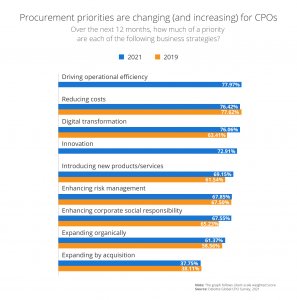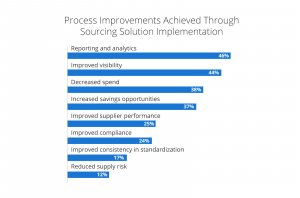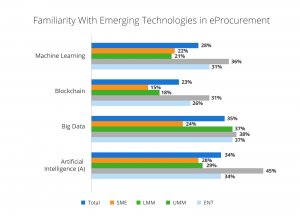The idea that leveraging technology is the key to long-term growth is a foregone conclusion in the minds of many business leaders. Agile start-ups regularly use technologies such as artificial intelligence, machine learning, application program interfaces, and blockchain to disrupt entire industries. As a result, established companies must adopt a digital procurement transformation strategy to remain viable in the markets that they serve. CPOs surveyed by Deloitte have identified digital transformation as a top priority.

Despite compelling benefits, a business operator may still be slow to roll out a digital procurement strategy. Despite the use of e-Procurement systems for the last 15 years, many aspects of procure to pay remain paper-based, manual, and prone to human error. Here are three areas of procurement that are ripe for digital transformation.
Digital Transformation in Procurement
1.Procurement Planning
Forecasting your organization’s purchasing activities is a key undertaking that happens during the budget cycle for many companies. We’ve previously discussed some of the best ways to optimize your procurement process cycle.
During this time, procurement agents lay out the costs for labor, expenses, and goods for upcoming projects. The acquisition of skilled labor at competitive rates is often more complex than simply purchasing generic computers or office equipment. In some cases, these workers help make purchasing decisions for network equipment, software services, and computer hardware.
According to a report by Deloitte, 51% of procurement leaders believe there to be a lack of ability within their procurement team to deliver on their organization’s procurement strategy. Getting the right people on contract for these projects is critical, but according to a Robert Half survey, nearly 76% of senior managers say that they’ve hired the wrong person for a position before.
These labor mismatches and ability gaps cost money. Contingent labor brings the flexibility to hire and let go of skilled workers without having to pay them pricey benefits or severance packages.
A digital procurement transformation would connect procurement and human resources (HR) teams to attract and retain the right talent for various projects. Procurement and HR agents could use artificial intelligence tools to quickly and accurately match contingent workers with project positions based on predefined experience, credentials, and work criteria. Using machine learning, adaptive job assessments, and predictive analytics tools, procurement and HR team members identify contingent labor candidates who will work well in specific roles. Augmented reality tours of work sites also attract star workers to your projects even before they do in-person interviews with hiring managers.
2. Sourcing
Most procurement contracts are used to cover standard projects that are completed within specified time periods. What about emergency purchases for customized parts that are needed as soon as possible in remote locations?
Let’s say a Texas oil extraction company owns an expensive piece of equipment that has a custom pump mechanism. The equipment is located at an overseas work site. If the pump mechanism breaks, the company’s operations in that region stop. The Texas company has similar customized equipment at all its global operations.
As a seasoned procurement agent, you recognize the risk to operations right away and try to avoid it by recommending buying spares in advance of an emergency. However, the costs to buy and store spares for various custom equipment around the world make this an inelegant solution in the minds of your senior managers. This highlights issues with visibility at different stages of the process.
According to a Levvel report, improved visibility across business spending is the top priority for improving back-office processes. By implementing a sourcing solution, organizations experience improvements like better visibility and also decreased spend.

3. Contract Management
Overseeing contracts with vendors, customers, and other stakeholders is at the heart of the procurement process. While some progressive organizations include digital elements such as electronic templates and eSignature tools within their contract management functions, many companies still rely on manual operations. Managing your contracts manually results in an overly complex contract management process that is prone to human error.
A report by Levvel lists the likes of inconsistency among contracts as well as contract creation, negotiation, and management among the biggest challenges.
However, contract management has the potential to be a key area of a digital procurement strategy given the many emerging technologies found in eProcurement solutions that can positively impact it.
Levvel’s Guide to Procure-to-Pay Digital Transformation discusses the increasing impact of Machine Learning, Blockchain, Big Data, and Artificial Intelligence within eProcurement, all of which offer great potential in the area of contract management.

Machine learning enables organizations to automatically match regular and predictable payments to an underlying contract, without the need for any supporting documents such as a PO or GRN. We discussed the benefits of contract matching and how it is supported by machine learning in another blog.
Big data analytics gives procurement teams the ability to compare each individual transaction made with the vendor contract it is linked to, allowing for real-time vendor performance monitoring.
With Artificial Intelligence software, organizations can protect themselves against the threat of fraudulent activity, such as vendors billing for the same order twice or an employee creating fake invoices. The software can both detect and highlight possible fraud cases but also help track the person responsible.
Blockchain technology can be used to streamline administrative activities by making transactions more transparent to all stakeholders. With blockchain, a suite of connected computers store and verify each recorded transaction, and all transactions are linked. As a procurement agent, you can quickly access a contract’s full, unaltered history. This information helps organizations analyze contract non-compliance, missed delivery dates, invoice discrepancies, and missed volume discounts.
Conclusion
Digital transformation in procurement often requires a company to have foundational e-procurement technology in place to reap the benefits of digital initiatives. Besides the financial investment that they need to build the right environment for digital transformation in procurement, business leaders must also justify digital transformation efforts to their shareholders and other stakeholders.
The building of a business case and getting others to embrace automation transformation can often be the biggest challenge. Many aren’t yet aware of the potential that technologies such as artificial intelligence and machine learning offer in the field of procurement, and that’s ok.
In this case, your organization’s digital procurement transformation is best done in phases. Start by setting a specific, measurable goal for your digitalization initiative and introduce the technology to your workforce to meet the goal. As your talent base gets familiar with these new technologies, they will think of other ways to use them that go beyond cost savings and into the realm of real value creation for your organization and its customers.



